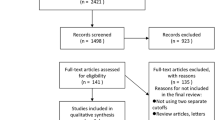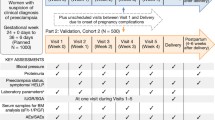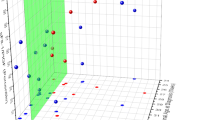Abstract
To evaluate the predictive value of the sFlt-1/PlGF ratio for the prediction of preeclampsia in women with preexisting diabetes mellitus. This is a monocentric retrospective observational study conducted between January 2018 and December 2020. All singleton pregnancies with preexisting diabetes mellitus, who had a dosage of the sFlt-1/PlGF ratio between 30 and 34 + 6 weeks of gestation were included. The principal outcome was preeclampsia. The secondary outcomes were preterm preeclampsia, gestational hypertension, placental abruption, intrauterine fetal death, IUGR, small for gestational age and a composite outcome named “hypertensive disorder of pregnancy” including gestational hypertension, preeclampsia and HELLP syndrome (hemolysis, elevated liver enzymes and low platelet count). Of 63 patients, 22% presented preeclampsia. The area under the curve of sFlt-1/PlGF ratio was 0.90 (95% CI: 0.79–0.96) for the prediction of preeclampsia. The receiver operator characteristic analysis suggested that the optimal sFlt-1/PlGF cutoff to predict preeclampsia was 29, with a sensitivity of 86% (95% CI: 60.1–96.0) and a specificity of 92% (95% CI: 80.8–96.8). A cut-off of 38 provided a sensitivity of 71% (95% CI: 45.4–88.3), a specificity of 92% (95% CI: 80.8–96.8). Further analysis using multivariable methods revealed nephropathy was significantly associated with PE (p = 0.014). The use of the sFlt-1/PlGF ratio during the third trimester of pregnancy seems to be of interest as a prognostic tool to improve multidisciplinary management of patients with preexisting diabetes mellitus.

Similar content being viewed by others
References
Phipps EA, Thadhani R, Benzing T, Karumanchi SA. Pre-eclampsia: pathogenesis, novel diagnostics and therapies. Nat Rev Nephrol. 2019;15(5):275–89.
Brown MA, Magee LA, Kenny LC, Karumanchi SA, McCarthy FP, Saito S, et al. Hypertensive disorders of pregnancy: ISSHP classification, diagnosis, and Management recommendations for International Practice. Hypertens. 2018;72(1):24–43.
Gestational Hypertension and Preeclampsia. ACOG Practice Bulletin, Number 222. Obstet Gynecol. 2020;135(6):e237–60.
Sibai BM. Risk factors, pregnancy complications, and prevention of hypertensive disorders in women with pregravid diabetes mellitus. J Matern Fetal Med. 2000;9(1):62–5.
Garner PR, D’Alton ME, Dudley DK, Huard P, Hardie M. Preeclampsia in diabetic pregnancies. Am J Obstet Gynecol. 1990;163(2):505–8.
Jensen DM, Damm P, Ovesen P, Molsted-Pedersen L, Beck-Nielsen H, Westergaard JG, et al. Microalbuminuria, preeclampsia, and preterm delivery in pregnant women with type 1 diabetes: results from a nationwide Danish study. Diabetes Care. 2010;33(1):90–4.
Ekbom P, Damm P, Feldt-Rasmussen B, Feldt-Rasmussen U, Molvig J, Mathiesen ER. Pregnancy outcome in type 1 Diabetic Women with microalbuminuria. Diabetes Care. 2001;1(10):1739–44.
Sibai BM, Caritis S, Hauth J, Lindheimer M, VanDorsten JP, MacPherson C, et al. Risks of preeclampsia and adverse neonatal outcomes among women with pregestational diabetes mellitus. Am J Obstet Gynecol. 2000;182(2):364–9.
Combs CA, Rosenn B, Kitzmiller JL, Khoury JC, Wheeler BC, Miodovnik M. Early-pregnancy proteinuria in diabetes related to preeclampsia. Obstet Gynecol. 1993;82(5):802–7.
Morrison JL, Hodgson LA, Lim LL, Al-Qureshi S. Diabetic retinopathy in pregnancy: a review. Clin Exp Ophthalmol. 2016;44(4):321–34.
Cundy T, Slee F, Gamble G, Neale L. Hypertensive disorders of pregnancy in women with type 1 and type 2 diabetes: original article. Diabet Med. 2002;19(6):482–9.
Guerby P, Swiader A, Augé N, Parant O, Vayssière C, Uchida K, et al. High glutathionylation of placental endothelial nitric oxide synthase in preeclampsia. Redox Biol. 2019;22:101126.
Guerby P, Tasta O, Swiader A, Pont F, Bujold E, Parant O, et al. Role of oxidative stress in the dysfunction of the placental endothelial nitric oxide synthase in preeclampsia. Redox Biol. 2021;40:101861.
Levine RJ, Lim KH, Schisterman EF, Sachs BP, Sibai BM, Karumanchi SA. Circulating angiogenic factors and the risk of preeclampsia. N Engl J Med. 2004;12.
Kendall RL, Thomas KA. Inhibition of vascular endothelial cell growth factor activity by an endogenously encoded soluble receptor. Proc Natl Acad Sci USA. 1993;90(22):10705–9.
Maynard SE, Min JY, Merchan J, Lim KH, Li J, Mondal S, et al. Excess placental soluble fms-like tyrosine kinase 1 (sFlt1) may contribute to endothelial dysfunction, hypertension, and proteinuria in preeclampsia. J Clin Invest. 2003;111(5):649–58.
Tasta O, Parant O, Hamdi SM, Allouche M, Vayssiere C, Guerby P. Evaluation of the prognostic value of the sFlt-1/PlGF ratio in early-onset preeclampsia. Am J Perinatol. 2021;38 (S 01):e292–8.
Cohen AL, Wenger JB, James-Todd T, Lamparello BM, Halprin E, Serdy S, et al. The association of circulating angiogenic factors and HbA1c with the risk of preeclampsia in women with preexisting diabetes. Hypertens Pregnancy. 2014;33(1):81–92.
Bonnet MP, Garnier M, Keita H, Compère V, Arthuis C, Raia-Barjat T, et al. Guidelines for the management of women with severe pre-eclampsia. Anaesth Crit Care Pain Med. 2021;40(5):100901.
AUDIPOG (n.d.) Courbes morphométriques néonatales. Available from https://www.audipog.net/Courbes-morpho.
Lévy P, Hamdi S, Guiboudenche J, Haguet MC, Bailleul S, Lefèvre G. Applying the concept of uncertainty to the sFlt-1/PlGF cut-offs for diagnosis and prognosis of preeclampsia. Clin Chem Lab Med. 2021;59(4):681–6.
Hund M, Allegranza D, Schoedl M, Dilba P, Verhagen-Kamerbeek W, Stepan H. Multicenter prospective clinical study to evaluate the prediction of short-term outcome in pregnant women with suspected preeclampsia (PROGNOSIS): study protocol. BMC Pregnancy Childbirth. 2014;14(1):324.
Hanson E, Rull K, Ratnik K, Vaas P, Teesalu P, Laan M. Value of soluble fms-like tyrosine kinase-1/placental growth factor test in third trimester of pregnancy for predicting preeclampsia in asymptomatic women. J Perinat Med. 2022;27(7):939–46.
Yu Y, Jenkins AJ, Nankervis AJ, Hanssen KF, Scholz H, Henriksen T, et al. Anti-angiogenic factors and pre-eclampsia in type 1 diabetic women. Diabetologia. 2009;52(1):160–8.
Moore Simas TA, Crawford SL, Solitro MJ, Frost SC, Meyer BA, Maynard SE. Angiogenic factors for the prediction of preeclampsia in high-risk women. Am J Obstet Gynecol. 2007;197(3):244. e1-244.e8.
Levine RJ, Lam C, Qian C, Yu KF, Maynard SE, Sachs BP, et al. Soluble endoglin and other circulating antiangiogenic factors in Preeclampsia. N Engl J Med. 2006;7(10):992–1005.
Bednarek-Jędrzejek M, Kwiatkowski S, Ksel-Hryciów J, Tousty P, Nurek K, Kwiatkowska E, et al. The sFlt-1/PlGF ratio values within the < 38, 38–85 and > 85 brackets as compared to perinatal outcomes. J Perinat Med. 2019;25(7):732–40.
Zeisler H, Llurba E, Chantraine F, Vatish M, Staff AC, Sennström M et al. Predictive value of the sFlt-1:PlGF ratio in women with suspected preeclampsia. N Engl J Med. 2016;374(1):13–22.
Jensen DM, Damm P, Moelsted-Pedersen L, Ovesen P, Westergaard JG, Moeller M, et al. Outcomes in type 1 diabetic pregnancies: a nationwide, population-based study. Diabetes Care. 2004;27(12):2819–23.
Persson M, Norman M, Hanson U. Obstetric and perinatal outcomes in type 1 diabetic pregnancies: a large, population-based study. Diabetes Care. 2009;32(11):2005–9.
Knight KM, Thornburg LL, Pressman EK. Pregnancy outcomes in type 2 diabetic patients as compared with type 1 diabetic patients and nondiabetic controls. J Reprod Med. 2012;57(9–10):397–404.
Vestgaard M, Sommer MC, Ringholm L, Damm P, Mathiesen ER. Prediction of preeclampsia in type 1 diabetes in early pregnancy by clinical predictors: a systematic review. J Matern Fetal Neonatal Med. 2018;31(14):1933–9.
Schröder W, Heyl W. [Diabetic nephropathy and pregnancy]. Z Geburtshilfe Neonatol. 1997;201(3):75–81.
Hiilesmaa V, Suhonen L, Teramo K. Glycaemic control is associated with pre-eclampsia but not with pregnancy-induced hypertension in women with type I diabetes mellitus. Diabetologia. 2000;43(12):1534–9.
Funding
The authors declare that no funds, grants, or other support were received during the preparation of this manuscript.
Author information
Authors and Affiliations
Contributions
PROVENDIER Anais, MIGLIORELLI Federico and GUERBY Paul analyzed data and wrote the manuscript. PROVENDIER Anais, GUYARD BOILEAU Beatrice, VAYSSIERE Christophe, M. HAMDI Safouane and DUPUIS Ninon collected data. LOUSSERT Lola and HANAIRE Helene reviewed the manuscript. PROVENDIER Anais and GUERBY Paul coordinated and designed research and edited the manuscript. GUERBY Paul is the guarantor of this work and, as such, had full access to all the data in the study and takes responsibility for the integrity of the data and the accuracy of the data analysis.
Corresponding author
Ethics declarations
Consent to Participate
Informed consent was obtained from all individual participants included in the study.
Competing Interests
The authors have no relevant financial or non-financial interests to disclose.
Additional information
Publisher’s Note
Springer Nature remains neutral with regard to jurisdictional claims in published maps and institutional affiliations.
Rights and permissions
Springer Nature or its licensor (e.g. a society or other partner) holds exclusive rights to this article under a publishing agreement with the author(s) or other rightsholder(s); author self-archiving of the accepted manuscript version of this article is solely governed by the terms of such publishing agreement and applicable law.
About this article
Cite this article
Provendier, A., Migliorelli, F., Loussert, L. et al. The sFLT-1/PlGF Ratio for the Prediction of Preeclampsia-Related Adverse Fetal and Maternal Outcomes in Women with Preexisting Diabetes. Reprod. Sci. (2024). https://doi.org/10.1007/s43032-024-01540-9
Received:
Accepted:
Published:
DOI: https://doi.org/10.1007/s43032-024-01540-9




